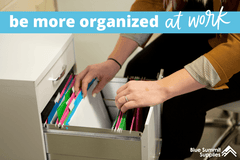Is your workplace a safe place to work for all employees? A safety committee joins managers and employees together to prioritize the safety of all levels of employees. In this post, we’ll break down what a safety committee does and share safety committee ideas, including how to start a safety committee at work and what to include in a workplace safety checklist.
What is a Health and Safety Committee?
A health and safety committee is a committee formed for a specific purpose: to bring together managers and employees to discuss and improve the occupational health and safety measures of their workplace. This type of committee is sometimes called the joint worksite health and safety committee, the workplace safety and health committee, or the occupational health and safety committee.
A health and safety committee will discuss health and safety policies and procedures, emergency plans, security measures, safety and operation manuals, injury rates, accident and incident reporting, workers’ compensation, safety inspections, and employee training.
Ultimately, the committee is a forum where both employees and managers can cooperate to improve conditions on the job and solve health and safety problems. The employees bring the practical and in-depth expertise they have of the organization’s specific tasks, and the managers bring a higher-level overview of company policies and procedures. For this reason, it’s essential that a health and safety committee have equal representation of both managers and employees as well as a diverse representation of the workforce.

How to Start a Safety Committee

1. Form a Committee of Safety
When forming a committee of safety at your workplace, you’ll first need to know whether there is a union for the employees and what their guidance is on forming the committee. If there is a union, they may have procedures that include how many people should be included, which departments they should represent, and how they are nominated or elected.
If your organization does not have union guidance on forming the committee, you will need to work with the appropriate manager to decide how to include participants. Who from the managerial team needs to be involved? Who will represent the department of health and safety? Will employees be able to self-nominate, or will the managerial team nominate them? You may consider forming a temporary joint working group to make these decisions to get the process in motion.

2. Set Safety Committee Roles and Responsibilities
There are several safety committee roles and responsibilities that will need to be filled. Depending on the size of the organization and how much there is to work out on health and safety, anywhere from 6-12 members is considered appropriate. The committee may become unmanageable if it is made up of too many people. But if the committee is too small, you may not adequately represent the various departments and interests within the organization.
At the highest level, the committee needs a sponsor. This is someone from the top level of management who can advise the committee from the managerial level on policies and procedures. They may or may not be present at every meeting, and the role may require more than one person, but the success of the committee often depends on the dedication of this role.
Next, a health and safety committee should have a chairperson whose role is to be the contact between the committee itself and the sponsor(s) of the committee. The liaison brings committee matters to the sponsor when they need to be addressed at a higher level of the organization. The chairperson will likely also act as the meeting manager, be at a supervisor level within the organization themselves, and have a genuine concern for the health and safety of the organization. They may also delegate tasks to committee members when appropriate.
A health and safety committee also needs an administrative support person to help reach its goals. Their duties include taking minutes and tracking the actions of the committee. They may also help take some of the work off the plate of the chairperson.
Finally, there should be a substantial number of employee representatives on the committee. They should represent all areas within the company, including departments such as manufacturing, maintenance, shipping and receiving, and office personnel. Their most important attribute is the specific knowledge of the employees they represent, especially their safety and health needs. They may also be specialists and have specific competencies, such as being the organization’s doctor or health and safety advisor.

3. Establish Goals and Best Safety Practices to Follow
The first actions to take when forming the committee include drafting a guiding document, such as a constitution or mission statement, as well as a document outlining procedures. Procedures might include when the committee will meet, what topics they will address, how to keep the committee organized, and how the committee will report on its progress. These documents will ensure the committee has a clear purpose and instructions for operation.
Once you’ve established how the committee will operate and its high-level mission, you’ll want to drill down into the short and long-term goals you wish to accomplish. Establishing health and safety best practices is a reasonable task for the committee to take on.
You’ll likely refer to the reasons the committee was formed for the most immediate goals: was there a major incident that needs to be prevented? Does the organization lack general safety guidelines and resources?

4. Plan Recurring Safety Committee Meetings
Establishing a regular meeting schedule is key to the success of the health and safety committee. The schedule should strike a balance between being frequent enough so that the committee can make progress towards its goals but not so frequent that the meetings interfere with people’s work schedules. The frequency may also be determined by how large the organization is and the amount of work the committee needs to accomplish to meet its goals.
While it's important to establish a meeting cadence to ensure consistent progress, the committee may also hold special meetings to address major safety incidents or changes to organizational personnel or equipment.
Potential office safety meeting topics may include:
- Lessons learned from a recent incident
- Safety concerns for upcoming periods of the year, such as hot summers or cold winters
- Training for various workplace risks
- Required safety documentation
- Discussions on what improved since the last meeting
- Review of any near misses and how to do better in the future
- Review of the health and safety statistics since the last meeting
- Special projects, inspections, etc.
Utilize a safety committee agenda template to plan ahead for each meeting. Creating a reusable safety meeting outline will save time before each meeting. The specific topics may vary for each meeting, but it’s helpful to start with the same basic structure.
An example safety meeting outline could include:
- Record of attendance
- Review of recent accidents, injuries, and other safety statistics
- Discussion of unfinished and new business
- Review or preparation of safety inspection reports
- Special projects or presentations
- Final thoughts, questions, feedback, or concerns

5. Document Progress and Publicize Success
When you complete each meeting, the chairperson should choose summary points to deliver to the sponsor so that management is aware of the committee’s progress and success.
It’s also a good idea to publicize the committee’s efforts to the employees represented by the committee and to ensure that other employees know how to submit feedback or suggestions to the committee. Their practical knowledge of the workplace may provide helpful information.

What to Include in Your Office Safety Checklist
An office safety checklist provides a structure for systematically reviewing all areas of the workplace that may create health and safety concerns. It is sometimes used when onboarding new staff, when inspecting or auditing safety procedures and equipment, or when following up after incidents. It is sometimes called an office safety inspection checklist or an office hazards checklist.
An office safety checklist may include specific items under several topical areas, such as:
- Emergency information
- Where is the nearest hospital?
- Where are emergency supplies, such as first aid kits?
- Are fire alarms, extinguishers, and exits in good condition?
- Have employees been trained in first aid and other emergency procedures?
- Safety manuals and procedures
- Are they up-to-date?
- Do you have adequate incident investigation procedures?
- How do employees raise concerns about safety procedures?
- Security
- Are premises secure during work hours?
- What are the procedures for managing threats and suspicious activity?
- Ergonomics
- Are employees sitting or standing currently at their workstations?
- Is equipment being used correctly?
- Do employees have adequate training in lifting techniques?
- Are employees taking adequate breaks and stretching regularly?
💡Learn How to Use Stretching Exercises to Prevent Workplace Injuries and Pain.
- Electrical
- Have all electronics in use been approved?
- Are electronics serviced regularly?
- Are there any damaged or frayed cords?
💡Read our guide to Desk Cable Management at Work.
- Housekeeping
- Are office supplies, tools, and furniture organized and clean?
- Is there adequate storage for supplies and unused items?
- Are common areas clean and accessible?
- Are entranceways and stairways clear?
- Staff amenities
- Are hot water taps appropriately marked?
- Are the bathrooms and kitchens cleaned regularly?
💡 Read our guide on How to Keep a Clean Office Kitchen.
- Other concerns
- Is there good lighting inside and outside the building?
- Is the noise level comfortable for all team members?
- Are workplace scents being managed for those who are sensitive to smell?
- Is there any other unsafe employee behavior to be concerned about?
Keep Your Workplace Safe
💡 Psychological Safety in the Workplace: What It Is and How to Achieve It
💡 Workplace DIY Hand Washing Station (With Printable Restroom Signs)
We’re passionate about helping teams stay safe in any work environment. Follow our office blog for the latest trends, safety strategies, product comparisons, wellness advice, and more.
If you have any questions or want to talk to someone about office supplies, send us an email or connect with us on Twitter, Facebook, or Instagram.










